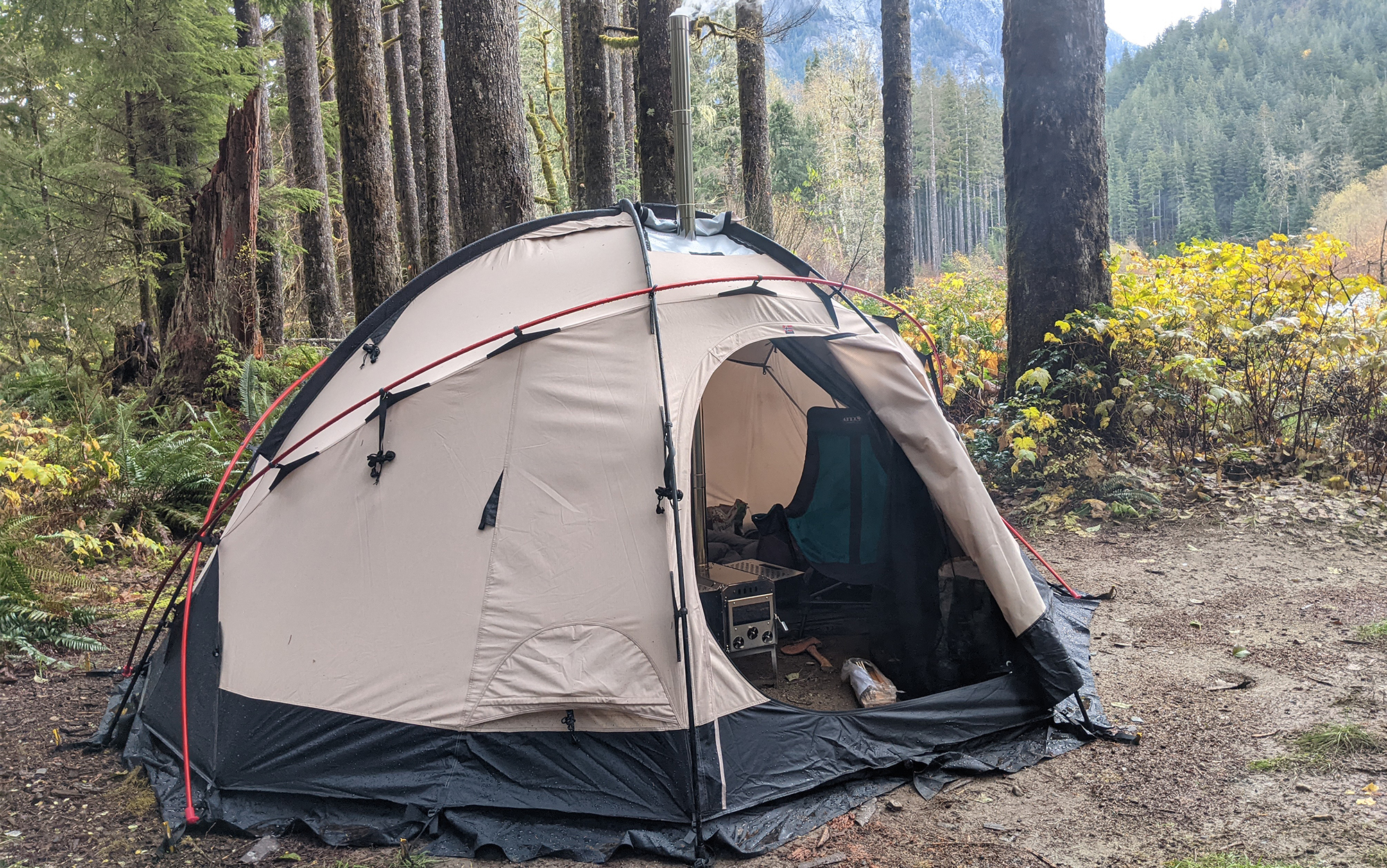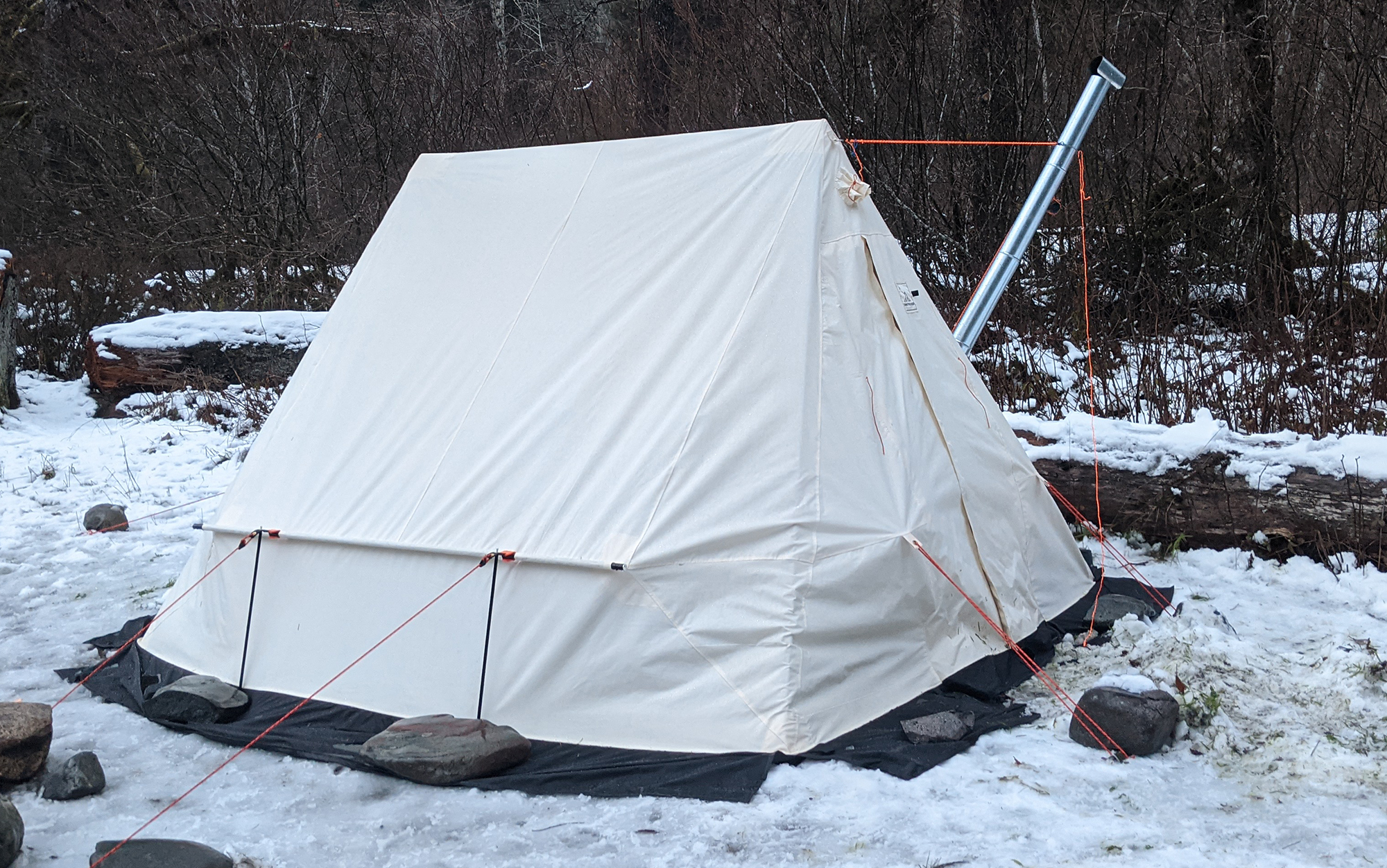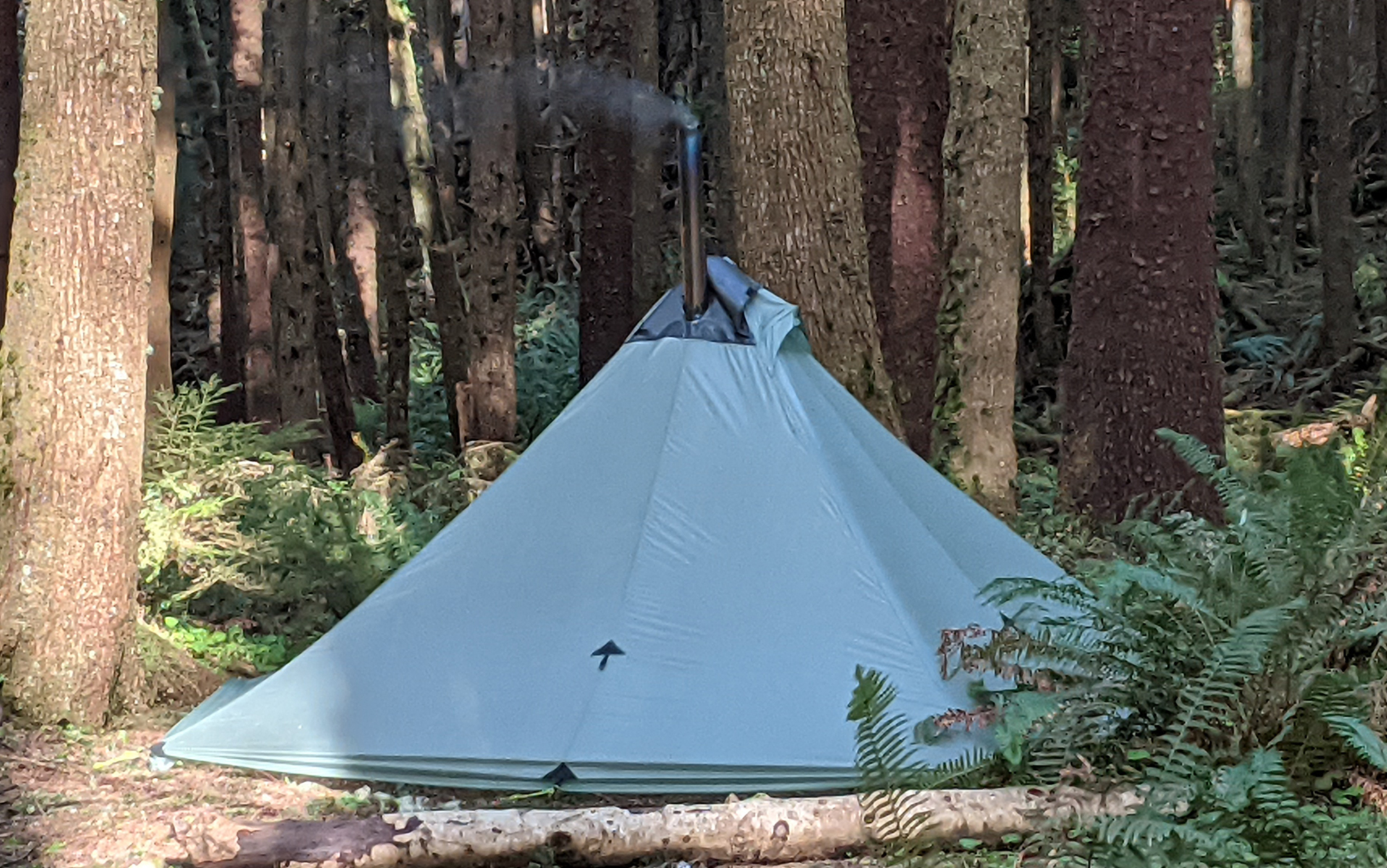The Best Hot Tents, Tested and Reviewed
Best Overall

Nortent Gamme 6
Best Interior Space

Snowtrekker Shortwall
Best for Backpacking

Seek Outside Cimarron
What if I told you that the advent of fall’s freezing rains doesn’t need to be the end of your camping season. Hot tents, or tents that are compatible with a wood-burning stove, are the best way to enjoy the outdoors during short days when temps dip below freezing. We tested the best hot tents, from Snowtrekker, Nortent, and Seek Outside in classic foul-weather Pacific Northwest conditions to see just how well they worked.
- Best Overall: Nortent Gamme 6
- Best Interior Space: Snowtrekker Shortwall
- Best for Backpacking: Seek Outside Cimarron
How I Tested the Best Hot Tents
I tested hot tents in the Pacific Northwest, overnight, during shoulder season conditions. The Seek Outside Cimarron was tested as part of ultralight backpacking gear test in April along the Oregon Coast, with overnight rain and temps dropping down into the forties. Both the Nortent Gamme and the Snowtrekker Shortwall were tested in late fall in the foothills of the Cascade Range in Washington State. Both testing weekends saw substantial overnight rain and temperature drops into the upper thirties.
The tents were assessed for packed size, ease of use, and functional interior space. The stoves were also assessed for packed size and ease of use, with an eye toward how much fuel they needed to warm the tent up and how easy it was to get airflow moving the right way so that smoke didn’t accumulate inside the tent.
Best Hot Tents: Reviews & Recommendations
Best Overall: Nortent Gamme 6
Key Features
- Weight: 16.75 pounds (tent), 37.5 pounds (stove)
- Pairs with Nortent stainless steel stove
- Available Add-ons: Floor, inner tent, gear pockets
Pros
- Simple to set up with a highly weather resistant exterior
- Dual entry and exit options
- The best stove of any tent I tested
Cons
- Difficult to maximize the interior space, especially with the inner tent
- Learning curve with the stove
The Nortent Gamme 6 was the package deal. Straightforward and easy to set up. Excellent protection against all manner of weather. And the best stove, in terms of ease of use, functionality, and aesthetics. Whether you are looking for a hunting base camp or trying to extend your camping season into the fall months and beyond, this is an excellent choice.
Even just out of the box, the quality of the build of the Nortent was evident. Both the tent (left in the above picture) and the stove (right) came in their own carry sacks, making them easy to transport. Assembly was straightforward, with color-coded poles fitting into sleeves, and secured at the base in a crisscross design for increased stability in foul weather. One aspect of the design that I appreciated is that the Nortent Gamme 6, similar to other tents from European manufacturers that we’ve tested, has the poles connect to the exterior shell (what American manufacturers would refer to as the rainfly but here is thick canvas). Then you can head inside your tent and stay dry while you clip together the inner tent lining.
The stove was also a breeze to set up. The pipes come in separate pieces that fit inside the body of the stove for transport, while the legs fold down from the outside. This was easily the fastest stove to set up of any that I looked at, and, aesthetically, it is beautiful. There is tempered glass on three sides of the stove, allowing you to monitor the coals without having to open the door to check. It’s very pleasant to look at, as if you are sitting around a campfire inside your tent. The Nortent Stainless Steel Stove also comes with a grate, so that the intake air can flow above and below the wood as it’s burning.
The other stoves I tested had a straightforward design: door on one side, with some air intake holes you could open and close. The stove interior was simply a box with a hole in the back for the stovepipe. Maybe it had a flue. But the Nortent stove was different, with a second sheet of stainless steel (baffle) below the stovepipe outlet running almost to the front of the stove. The primary benefit of this design is that the hot air has to travel a longer distance as it snakes its way toward the stovepipe, dispelling more warmth into your tent as it goes.
To help you even further maximize its heating potential, you can open a second set of air intake valves at the top of the stove so that the smoke fully combusts (even more heat) before exiting the stove pipe. That means you need less fuel while getting a cleaner burn and generating more heat. It’s a very effective design: On the night that we tested this tent and stove setup, we burned a small packet of kindling and were plenty cozy. It was also the only stove I tested that I didn’t have to “burn in” once before taking out into the field.
The catch is that it takes some getting used to. Hot tent wood-burning stoves should be heated up slowly at first, as until the stove pipe itself has started to warm up some, the negative pressure created by the cold air outside the tent will prevent the smoke from exiting the stove pipe efficiently. Instead, the smoke buildup inside the stove will try to escape by any means necessary out the air intake holes or even the seams of the stove itself.
While trying to get the hang of this stove, I twice smoked myself out of the tent entirely. I would be very cautious about opening up that second set of air intakes on the top of the door (my initial error), as the smoke is traveling toward the top of the door as it journeys toward the stovepipe. But once you get the hang of it, it’s intuitive and works well.
While I tested the Nortent with the inner tent accessory, I would recommend most individuals purchase a floor instead. The size and shape of the inner tent combined with the dome shape of the tent itself overly restricts your usable space. There was too much space in the inner tent for our gear, and not enough outside of it to put our chairs next to the stove. We also found that it was more difficult to create a cross breeze inside the tent, as the inner tent blocked access to the door on the opposite side. But this is a minor quibble, easily solved by opting for the floor accessory instead of the inner tent.
Best Interior Space: Snowtrekker Shortwall
Key Features
- Weight: 19.1 pounds (tent), 22 pounds (stove)
- Pairs with a small stove
- Available Add-ons: Carry bag, floor, window, additional door, mosquito netting, stove jack hole cover
Pros
- Great interior space
Cons
- Somewhat complicated tent setup
- Stove was fairly difficult to set up (but not to use)
One problem with most hot tents is that the stoves need to be centrally located in the tent. This breaks up the interior space, often turning what should be a four-person tent into something that only two people can realistically use. The Snowtrekker Shortwall was a notable exception to this trend: It has the stove tucked away in the front left corner of the tent. This design meant that even though it had a smaller interior footprint than the Gamme 6, it had a much roomier interior feel, an effect aided by the tent’s overall design.
This tent had one of the most unusual setups of anything I’ve tested. It starts with a sawhorse-type pole construction. Two legs are positioned into an orange joint, with a third pole coming out the side; it connects on the opposite end with another orange joint and two more legs. None of these segments locked into place, so you have to be a bit careful when assembling them — it twice fell down on me while I was putting it together. After you get it up, you then throw the canvas body over the top (don’t be surprised if the pole segments fall apart a bit during this step, too). Once it’s over and positioned, the four pole ends at the bottom of the sawhorse slip into the corners of the tent, which finally creates enough tension to keep the whole thing together.
Three more poles are positioned horizontally through sleeves on the sides and the back of the tent, with shorter poles connecting to the base to create the vertical walls: This part works well and goes faster than you expect. Because this tent could be described as semi-freestanding, you do need to figure out how to create tension between the guylines using stakes. If it’s still early in the season, you should be able to stake directly into the ground (although plan to bring your own stakes, as the beefy military ones supplied by Snowtrekker are less effective at piercing the ground than other models).
Conversely, if the ground is covered in snow, you can simply pile snow on top of the stakes. However, if the ground is frozen or otherwise impenetrable, but without the benefit of heavy snow, you’ll need to Macgyver things a bit. I used rocks to hold the stakes in place which worked well enough to set up the tent.
Once the tent is set up, you can move onto the stove. The body of the stove itself is fairly straightforward: simply unfold the legs and you’re in business. The stove pipe is a bit trickier. The pieces nest together in a narrowing concave shape; however, I found that in practice they didn’t always fit together, or come apart, very easily. Snowtrekker recommends you use work gloves when fitting the parts together, too, as the sharp edges can cut your hands. (I did not wear gloves and can confirm that they will in fact cut your hands).
Further complicating matters is the adjustable stove pipe piece, which allows you to swivel the direction of the stove pipe so that it’s pointed at a 45-degree angle out the side of your tent. In theory, I like the versatility of this, as it gives you more control on the orientation of your stove; in practice, this piece was difficult to adjust and, after much swearing, I ended up settling for a so-so orientation in the tent.
Fortunately, the interior space of the Snowtrekker Shortwall is so generous that it doesn’t matter. Between the off-set positioning of the stove and the vertical side walls of the tent body, this tent easily had enough room for four adults to sleep inside of it, and still have plenty of space for a couple of the best backpacking chairs. Two people were practically swimming in it. I also found that the vents at the top of the tent did a remarkably good job of allowing for air transfer across the body of the tent, even when we were first getting the fire going in the stove and it was a little smoky.
One final quibble I have about the Snowtrekker is that they do not include a carrying bag in the purchase price, for either the stove, or the tent itself. Between the canvas body, pole bag, tent stake, and ground sheet (sold separately, but recommended), there are a lot of pieces to this tent. If you do not have a large canvas bag on hand to store this in, plan to add their storage bag to your cart.
Best for Backpacking: Seek Outside Cimarron
Key Features
- Weight: 3.5 pounds (tent), 2.75 pounds (stove)
- Pairs with Seek Outside titanium stoves
- Available Add-ons: Screen doors, seam-sealing, carbon pole, inner tent
Pros
- Tent sets up lightning fast
- Surprisingly lightweight and compact
- Possible to fit four people plus a stove if you are very careful
- Excellent stakes included
Cons
- Stove must be assembled and reassembled each time, with a number of small, easy to lose parts
- Smaller models of the stove do not fit typical firewood
The Nortent Gamme 6 and the Snowtrekker Shortwall are surprisingly lightweight and compact for what they are, but they are still classic camping tents. You would not want to take these on any kind of trek into the backcountry. The Seek Outside Cimarron, is not only lightweight enough to carry into the backcountry, it could even be considered ultralight if you were splitting the weight with multiple other people. That’s a game changer for backpackers who are used to calling it quits when the seasons shift.
I first slept in this tent as part of the Outdoor Life test of the best ultralight tents, and was surprised at how quickly it set up. Once I found a suitably large spot (easily the most time-consuming part of the process), I had it up in only a couple of minutes. The first step is to stake out the four corners of the tent, a task made easier by the long (almost 10 inches) twisted aluminum stakes. Then simply assemble the pole sections together at the lowest length setting, position it in the center of the tent, and adjust it up until it’s at its highest setting.
The titanium stove, however, is much harder to assemble. To get it small enough to fit into a typical backpacking backpack, it breaks down into six different pieces for the stove body, as well as four pegs for the legs and screws to hold it all in place. That’s a lot of pieces to keep track of, and you’ll want to do a thorough accounting to make sure you have everything when heading out into the field and packing up to head home.
The stove pipe itself is, fortunately, a little bit easier to manage. It’s essentially a flat, thin piece of titanium that rolls two ways: short-ways to pack away for travel, and long-ways to roll up as your stove pipe. Rings hold into place whichever configuration it’s in. This is time consuming to set up, and because these are thin pieces of titanium, it does take some care in handling so that it doesn’t get bent out of shape. But, trust me, it’s worth it.
Because this one is made out of thin pieces of titanium, rather than thicker slabs of stainless steel, it conducts heat remarkably well. Just burning a few twigs inside of it will noticeably warm up the inside of your tent.
How to Choose a Hot Tent
Purpose
There is a surprisingly wide variety of hot tents on the market, ranging from models that you could use for a glamping setup to lightweight designs appropriate for backpacking, rugged spacious models built for hunting camps, and more. The models we tested for this story only account for a fraction of what these brands offer (Nortent, in particular, has a wide range of stove-compatible tent designs). If you don’t see the perfect tent for your needs in this story, chances are one of these brands carries it.
Stove Compatibility
Most hot tents are simply tents built to house a wood-burning stove; often, you’ll need to purchase the stove separately. In some instances you may be able to mix and match stoves with tent brands, but not always.
Interior Space
Not only do wood-burning stoves take up a fair amount of space inside of a hot tent, you also need to give yourself a buffer around it for safety. Even accidentally brushing up against the side of one of these is enough to burn you. Plan for more interior space than you think you need when making a hot tent purchase.
FAQs
A hot tent is a tent that is designed to be paired with a wood-burning stove. They typically do not have floors and do have stovepipe openings.
Hot tents do not have floors because the high heat of the stove can melt the floors. Several of the tents I looked at, including the Nortent Gamme 6 and the Snowtrekker Shortwall, did have options to include partial floors or additional materials that could be used to prevent the heat of the stove from melting the floor.
After testing numerous hot tents in significant downpours in the Pacific Northwest without incident, I’m confident saying that yes, hot tents are waterproof. The biggest fail point for a hot tent is the stovepipe opening. There was water dripping through the hole around the stovepipe opening in the Snowtrekker Shortwall that I tested.
Final Thoughts on the Best Hot Tents
After testing different hot tent models in rain, wind, and snow, I’ve been impressed by the variety and quality of design from manufacturers such as Seek Outside, Nortent, and Snowtrekker. If you’ve been hesitating on purchasing a hot tent for use in the shoulder season and beyond, any of the options on this list would be a great place to start your hot tent journey with.
- Best Overall: Nortent Gamme 6
- Best Interior Space: Snowtrekker Shortwall
- Best for Backpacking: Seek Outside Cimarron
The post The Best Hot Tents, Tested and Reviewed appeared first on Outdoor Life.
We may earn revenue from the products available on this page and participate in affiliate programs. Learn More ›




